Helicobacter pylori Neutrophil-Activating Protein Directly Interacts with and Activates Toll-like Receptor 2 to Induce the Secretion of Interleukin-8 from Neutrophils and ATRA-Induced Differentiated HL-60 Cells
Abstract
1. Introduction
2. Results
2.1. ATRA-Induced Differentiated HL-60 Cells as a Neutrophil Model to Study HP-NAP-Induced ROS Production
2.2. Involvement of PTX-Sensitive Heterotrimeric G Proteins in HP-NAP-Induced ROS Production in ATRA-Induced Differentiated HL-60 Cells
2.3. HP-NAP-Induced PTX-Sensitive Heterotrimeric G Protein-Dependent Activation of ERK1/2 and p38-MAPK to Elicit ROS Production in ATRA-Induced Differentiated HL-60 Cells
2.4. TLR2-Independent ROS Production in Neutrophils and ATRA-Induced Differentiated HL-60 Cells Induced by HP-NAP
2.5. Involvement of TLR2 and PTX-Sensitive Heterotrimeric G Proteins in HP-NAP-Induced IL-8 Secretion by Neutrophils and ATRA-Induced Differentiated HL-60 Cells
2.6. Specific Physical Interaction between HP-NAP and TLR2
3. Discussion
4. Materials & Methods
4.1. Cell Culture and Differentiation
4.2. Flow Cytometry
4.3. Isolation of Human Neutrophils
4.4. Expression and Purification of HP-NAP by Gel-Filtration Chromatography
4.5. Pretreatment with Inhibitors and Antibodies
4.6. Measurement of ROS Production by NBT Reduction Assay
4.7. Measurement of ROS Production by DHE Fluorescence Assay
4.8. Measurement of ROS Production by H2DCF-DA-Derived Fluorescence Assay
4.9. Immunoblotting
4.10. IL-8 Release Assay
4.11. ELISA-Based Solid-Phase Binding Assay
4.12. Competitive ELISA Binding Assay
4.13. Statistical Analysis
Supplementary Materials
Author Contributions
Funding
Institutional Review Board Statement
Informed Consent Statement
Data Availability Statement
Acknowledgments
Conflicts of Interest
References
- Kusters, J.G.; van Vliet, A.H.; Kuipers, E.J. Pathogenesis of Helicobacter pylori infection. Clin. Microbiol. Rev. 2006, 19, 449–490. [Google Scholar] [CrossRef] [PubMed]
- Fiocca, R.; Luinetti, O.; Villani, L.; Chiaravalli, A.M.; Capella, C.; Solcia, E. Epithelial cytotoxicity, immune responses, and inflammatory components of Helicobacter pylori gastritis. Scand. J. Gastroenterol. Suppl. 1994, 205, 11–21. [Google Scholar] [CrossRef]
- Warren, J.R.; Marshall, B. Unidentified curved bacilli on gastric epithelium in active chronic gastritis. Lancet 1983, 1, 1273–1275. [Google Scholar]
- Xu, X.Q.; Wang, Z.H.; Liao, J.X.; Chen, X.Y.; Liu, W.Z.; Xiao, S.D.; Lu, H. Predictive value of neutrophil infiltration as a marker of Helicobacter pylori infection. World J. Gastroenterol. 2012, 18, 5101–5105. [Google Scholar] [CrossRef]
- Zanotti, G.; Papinutto, E.; Dundon, W.; Battistutta, R.; Seveso, M.; Giudice, G.; Rappuoli, R.; Montecucco, C. Structure of the neutrophil-activating protein from Helicobacter pylori. J. Mol. Biol. 2002, 323, 125–130. [Google Scholar] [CrossRef]
- Tonello, F.; Dundon, W.G.; Satin, B.; Molinari, M.; Tognon, G.; Grandi, G.; Del Giudice, G.; Rappuoli, R.; Montecucco, C. The Helicobacter pylori neutrophil-activating protein is an iron-binding protein with dodecameric structure. Mol. Microbiol. 1999, 34, 238–246. [Google Scholar] [CrossRef]
- Evans, D.J., Jr.; Evans, D.G.; Takemura, T.; Nakano, H.; Lampert, H.C.; Graham, D.Y.; Granger, D.N.; Kvietys, P.R. Characterization of a Helicobacter pylori neutrophil-activating protein. Infect Immun. 1995, 63, 2213–2220. [Google Scholar] [CrossRef]
- Satin, B.; Del Giudice, G.; Della Bianca, V.; Dusi, S.; Laudanna, C.; Tonello, F.; Kelleher, D.; Rappuoli, R.; Montecucco, C.; Rossi, F. The neutrophil-activating protein (HP-NAP) of Helicobacter pylori is a protective antigen and a major virulence factor. J. Exp. Med. 2000, 191, 1467–1476. [Google Scholar] [CrossRef] [PubMed]
- Polenghi, A.; Bossi, F.; Fischetti, F.; Durigutto, P.; Cabrelle, A.; Tamassia, N.; Cassatella, M.A.; Montecucco, C.; Tedesco, F.; de Bernard, M. The neutrophil-activating protein of Helicobacter pylori crosses endothelia to promote neutrophil adhesion in vivo. J. Immunol. 2007, 178, 1312–1320. [Google Scholar] [CrossRef]
- Wang, C.A.; Liu, Y.C.; Du, S.Y.; Lin, C.W.; Fu, H.W. Helicobacter pylori neutrophil-activating protein promotes myeloperoxidase release from human neutrophils. Biochem. Biophys. Res. Commun. 2008, 377, 52–56. [Google Scholar] [CrossRef][Green Version]
- D’Elios, M.M.; Amedei, A.; Cappon, A.; Del Prete, G.; de Bernard, M. The neutrophil-activating protein of Helicobacter pylori (HP-NAP) as an immune modulating agent. FEMS Immunol. Med. Microbiol. 2007, 50, 157–164. [Google Scholar] [CrossRef]
- Nishioka, H.; Baesso, I.; Semenzato, G.; Trentin, L.; Rappuoli, R.; Del Giudice, G.; Montecucco, C. The neutrophil-activating protein of Helicobacter pylori (HP-NAP) activates the MAPK pathway in human neutrophils. Eur. J. Immunol. 2003, 33, 840–849. [Google Scholar] [CrossRef]
- Amedei, A.; Cappon, A.; Codolo, G.; Cabrelle, A.; Polenghi, A.; Benagiano, M.; Tasca, E.; Azzurri, A.; D’Elios, M.M.; Del Prete, G.; et al. The neutrophil-activating protein of Helicobacter pylori promotes Th1 immune responses. J. Clin. Investig. 2006, 116, 1092–1101. [Google Scholar] [CrossRef]
- Del Prete, G.; Chiumiento, L.; Amedei, A.; Piazza, M.; D’Elios, M.M.; Codolo, G.; de Bernard, M.; Masetti, M.; Bruschi, F. Immunosuppression of TH2 responses in Trichinella spiralis infection by Helicobacter pylori neutrophil-activating protein. J. Allergy Clin. Immunol. 2008, 122, 908–913. [Google Scholar] [CrossRef] [PubMed]
- Alvarez-Arellano, L.; Camorlinga-Ponce, M.; Maldonado-Bernal, C.; Torres, J. Activation of human neutrophils with Helicobacter pylori and the role of Toll-like receptors 2 and 4 in the response. FEMS Immunol. Med. Microbiol. 2007, 51, 473–479. [Google Scholar] [CrossRef]
- Kolaczkowska, E.; Kubes, P. Neutrophil recruitment and function in health and inflammation. Nat. Rev. Immunol. 2013, 13, 159–175. [Google Scholar] [CrossRef] [PubMed]
- Thomas, C.J.; Schroder, K. Pattern recognition receptor function in neutrophils. Trends Immunol. 2013, 34, 317–328. [Google Scholar] [CrossRef] [PubMed]
- Futosi, K.; Fodor, S.; Mocsai, A. Neutrophil cell surface receptors and their intracellular signal transduction pathways. Int. Immunopharmacol. 2013, 17, 638–650. [Google Scholar] [CrossRef]
- Krabbe, J.; Beilmann, V.; Alamzad-Krabbe, H.; Boll, S.; Seifert, A.; Ruske, N.; Kraus, T.; Martin, C. Blood collection technique, anticoagulants and storing temperature have minor effects on the isolation of polymorphonuclear neutrophils. Sci. Rep. 2020, 10, 14646. [Google Scholar] [CrossRef]
- Tak, T.; Tesselaar, K.; Pillay, J.; Borghans, J.A.; Koenderman, L. What’s your age again? Determination of human neutrophil half-lives revisited. J. Leukoc. Biol. 2013, 94, 595–601. [Google Scholar] [CrossRef]
- Birnie, G.D. The HL60 cell line: A model system for studying human myeloid cell differentiation. Br. J. Cancer Suppl. 1988, 9, 41–45. [Google Scholar]
- Breitman, T.R.; Selonick, S.E.; Collins, S.J. Induction of differentiation of the human promyelocytic leukemia cell line (HL-60) by retinoic acid. Proc. Natl. Acad. Sci. USA 1980, 77, 2936–2940. [Google Scholar] [CrossRef]
- Collins, S.J.; Ruscetti, F.W.; Gallagher, R.E.; Gallo, R.C. Terminal differentiation of human promyelocytic leukemia cells induced by dimethyl sulfoxide and other polar compounds. Proc. Natl. Acad. Sci. USA 1978, 75, 2458–2462. [Google Scholar] [CrossRef]
- Alyami, H.M.; Finoti, L.S.; Teixeira, H.S.; Aljefri, A.; Kinane, D.F.; Benakanakere, M.R. Role of NOD1/NOD2 receptors in Fusobacterium nucleatum mediated NETosis. Microb. Pathog. 2019, 131, 53–64. [Google Scholar] [CrossRef] [PubMed]
- Blanter, M.; Gouwy, M.; Struyf, S. Studying Neutrophil Function in vitro: Cell Models and Environmental Factors. J. Inflamm. Res. 2021, 14, 141–162. [Google Scholar] [CrossRef] [PubMed]
- Hua, J.; Hasebe, T.; Someya, A.; Nakamura, S.; Sugimoto, K.; Nagaoka, I. Evaluation of the expression of NADPH oxidase components during maturation of HL-60 cells to neutrophil lineage. J. Leukoc. Biol. 2000, 68, 216–224. [Google Scholar] [PubMed]
- Inoue, Y.; Yagisawa, M.; Saeki, K.; Imajoh-Ohmi, S.; Kanegasaki, S.; Yuo, A. Induction of phagocyte oxidase components during human myeloid differentiation: Independent protein expression and discrepancy with the function. Biosci. Biotechnol. Biochem. 2001, 65, 2581–2584. [Google Scholar] [CrossRef][Green Version]
- Jann, N.J.; Schmaler, M.; Ferracin, F.; Landmann, R. TLR2 enhances NADPH oxidase activity and killing of Staphylococcus aureus by PMN. Immunol. Lett. 2011, 135, 17–23. [Google Scholar] [CrossRef]
- Xu, F.; Zhang, C.; Zou, Z.; Fan, E.K.Y.; Chen, L.; Li, Y.; Billiar, T.R.; Wilson, M.A.; Shi, X.; Fan, J. Aging-related Atg5 defect impairs neutrophil extracellular traps formation. Immunology 2017, 151, 417–432. [Google Scholar] [CrossRef]
- Mukherjee, S.; Karmakar, S.; Babu, S.P. TLR2 and TLR4 mediated host immune responses in major infectious diseases: A review. Braz. J. Infect. Dis. 2016, 20, 193–204. [Google Scholar] [CrossRef]
- Sabroe, I.; Dower, S.K.; Whyte, M.K. The role of Toll-like receptors in the regulation of neutrophil migration, activation, and apoptosis. Clin. Infect. Dis. 2005, 41, S421–S426. [Google Scholar] [CrossRef]
- Starost, L.J.; Karassek, S.; Sano, Y.; Kanda, T.; Kim, K.S.; Dobrindt, U.; Ruter, C.; Schmidt, M.A. Pertussis toxin exploits host cell signaling pathways induced by meningitis-causing E. coli K1-RS218 and enhances adherence of monocytic THP-1 cells to human cerebral endothelial cells. Toxins 2016, 8, 291. [Google Scholar] [CrossRef]
- Iankov, I.D.; Penheiter, A.R.; Carlson, S.K.; Galanis, E. Development of monoclonal antibody-based immunoassays for detection of Helicobacter pylori neutrophil-activating protein. J. Immunol. Methods 2012, 384, 1–9. [Google Scholar] [CrossRef] [PubMed][Green Version]
- Hayashi, F.; Means, T.K.; Luster, A.D. Toll-like receptors stimulate human neutrophil function. Blood 2003, 102, 2660–2669. [Google Scholar] [CrossRef] [PubMed]
- Sun, L.; Ye, R.D. Role of G protein-coupled receptors in inflammation. Acta Pharmacol. Sin. 2012, 33, 342–350. [Google Scholar] [CrossRef]
- Zaidi, A.K.; Thangam, E.R.; Ali, H. Distinct roles of Ca2+ mobilization and G protein usage on regulation of Toll-like receptor function in human and murine mast cells. Immunology 2006, 119, 412–420. [Google Scholar] [CrossRef] [PubMed]
- Jin, M.; Yu, B.; Zhang, W.; Zhang, W.; Xiao, Z.; Mao, Z.; Lai, Y.; Lin, D.; Ma, Q.; Pan, E.; et al. Toll-like receptor 2-mediated MAPKs and NF-kappaB activation requires the GNAO1-dependent pathway in human mast cells. Integr. Biol. 2016, 8, 968–975. [Google Scholar] [CrossRef]
- Dauphinee, S.M.; Voelcker, V.; Tebaykina, Z.; Wong, F.; Karsan, A. Heterotrimeric Gi/Go proteins modulate endothelial TLR signaling independent of the MyD88-dependent pathway. Am. J. Physiol. Heart Circ. Physiol. 2011, 301, H2246–H2253. [Google Scholar] [CrossRef]
- Rallabhandi, P.; Nhu, Q.M.; Toshchakov, V.Y.; Piao, W.; Medvedev, A.E.; Hollenberg, M.D.; Fasano, A.; Vogel, S.N. Analysis of proteinase-activated receptor 2 and TLR4 signal transduction: A novel paradigm for receptor cooperativity. J. Biol. Chem. 2008, 283, 24314–24325. [Google Scholar] [CrossRef]
- Tamura, M.; Nogimori, K.; Murai, S.; Yajima, M.; Ito, K.; Katada, T.; Ui, M.; Ishii, S. Subunit structure of islet-activating protein, pertussis toxin, in conformity with the A-B model. Biochemistry 1982, 21, 5516–5522. [Google Scholar] [CrossRef]
- Mangmool, S.; Kurose, H. G(i/o) protein-dependent and -independent actions of pertussis toxin (PTX). Toxins 2011, 3, 884–899. [Google Scholar] [CrossRef] [PubMed]
- Katada, T.; Tamura, M.; Ui, M. The A protomer of islet-activating protein, pertussis toxin, as an active peptide catalyzing ADP-ribosylation of a membrane protein. Arch. Biochem. Biophys. 1983, 224, 290–298. [Google Scholar] [CrossRef]
- Garcia, J.G.; Wang, P.; Schaphorst, K.L.; Becker, P.M.; Borbiev, T.; Liu, F.; Birukova, A.; Jacobs, K.; Bogatcheva, N.; Verin, A.D. Critical involvement of p38 MAP kinase in pertussis toxin-induced cytoskeletal reorganization and lung permeability. FASEB J. 2002, 16, 1064–1076. [Google Scholar] [CrossRef] [PubMed]
- Wang, Z.Y.; Yang, D.; Chen, Q.; Leifer, C.A.; Segal, D.M.; Su, S.B.; Caspi, R.R.; Howard, Z.O.; Oppenheim, J.J. Induction of dendritic cell maturation by pertussis toxin and its B subunit differentially initiate Toll-like receptor 4-dependent signal transduction pathways. Exp. Hematol. 2006, 34, 1115–1124. [Google Scholar] [CrossRef]
- Sindt, K.A.; Hewlett, E.L.; Redpath, G.T.; Rappuoli, R.; Gray, L.S.; Vandenberg, S.R. Pertussis toxin activates platelets through an interaction with platelet glycoprotein Ib. Infect. Immun. 1994, 62, 3108–3114. [Google Scholar] [CrossRef] [PubMed]
- Melien, O.; Sandnes, D.; Johansen, E.J.; Christoffersen, T. Effects of pertussis toxin on extracellular signal-regulated kinase activation in hepatocytes by hormones and receptor-independent agents: Evidence suggesting a stimulatory role of G(i) proteins at a level distal to receptor coupling. J. Cell Physiol. 2000, 184, 27–36. [Google Scholar] [CrossRef]
- Li, H.; Wong, W.S. Pertussis toxin activates tyrosine kinase signaling cascade in myelomonocytic cells: A mechanism for cell adhesion. Biochem. Biophys. Res. Commun. 2001, 283, 1077–1082. [Google Scholar] [CrossRef]
- Pantelic, M.; Chen, I.; Parker, J.; Zhang, P.; Grunert, F.; Chen, T. Retinoic acid treated HL60 cells express CEACAM1 (CD66a) and phagocytose Neisseria gonorrhoeae. FEMS Immunol. Med. Microbiol. 2004, 42, 261–266. [Google Scholar] [CrossRef][Green Version]
- Tsiftsoglou, A.S.; Wong, W.; Hyman, R.; Minden, M.; Robinson, S.H. Analysis of commitment of human leukemia HL-60 cells to terminal granulocytic maturation. Cancer Res. 1985, 45, 2334–2339. [Google Scholar]
- Rincon, E.; Rocha-Gregg, B.L.; Collins, S.R. A map of gene expression in neutrophil-like cell lines. BMC Genomics 2018, 19, 573. [Google Scholar] [CrossRef]
- Huang, S.; Eichler, G.; Bar-Yam, Y.; Ingber, D.E. Cell fates as high-dimensional attractor states of a complex gene regulatory network. Phys. Rev. Lett. 2005, 94, 128701. [Google Scholar] [CrossRef] [PubMed]
- Collins, S.J.; Gallo, R.C.; Gallagher, R.E. Continuous growth and differentiation of human myeloid leukaemic cells in suspension culture. Nature 1977, 270, 347–349. [Google Scholar] [CrossRef] [PubMed]
- Hong, Z.W.; Yang, Y.C.; Pan, T.; Tzeng, H.F.; Fu, H.W. Differential effects of DEAE negative mode chromatography and gel-filtration chromatography on the charge status of Helicobacter pylori neutrophil-activating protein. PLoS ONE 2017, 12, e0173632. [Google Scholar] [CrossRef] [PubMed]
- Yang, Y.C.; Kuo, T.Y.; Hong, Z.W.; Chang, H.W.; Chen, C.C.; Tsai, T.L.; Fu, H.W. High yield purification of Helicobacter pylori neutrophil-activating protein overexpressed in Escherichia coli. BMC Biotechnol. 2015, 15, 23. [Google Scholar] [CrossRef] [PubMed]
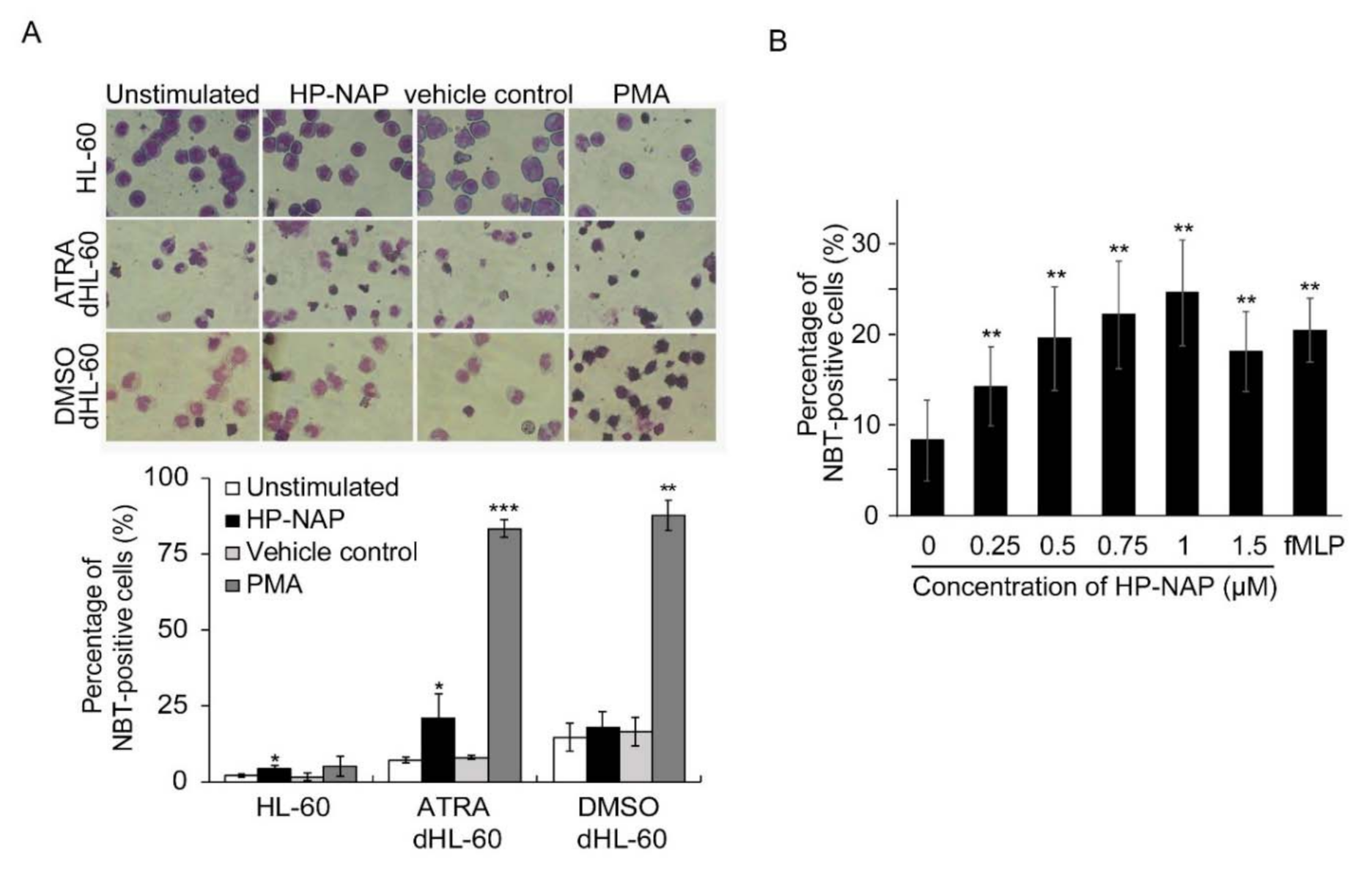

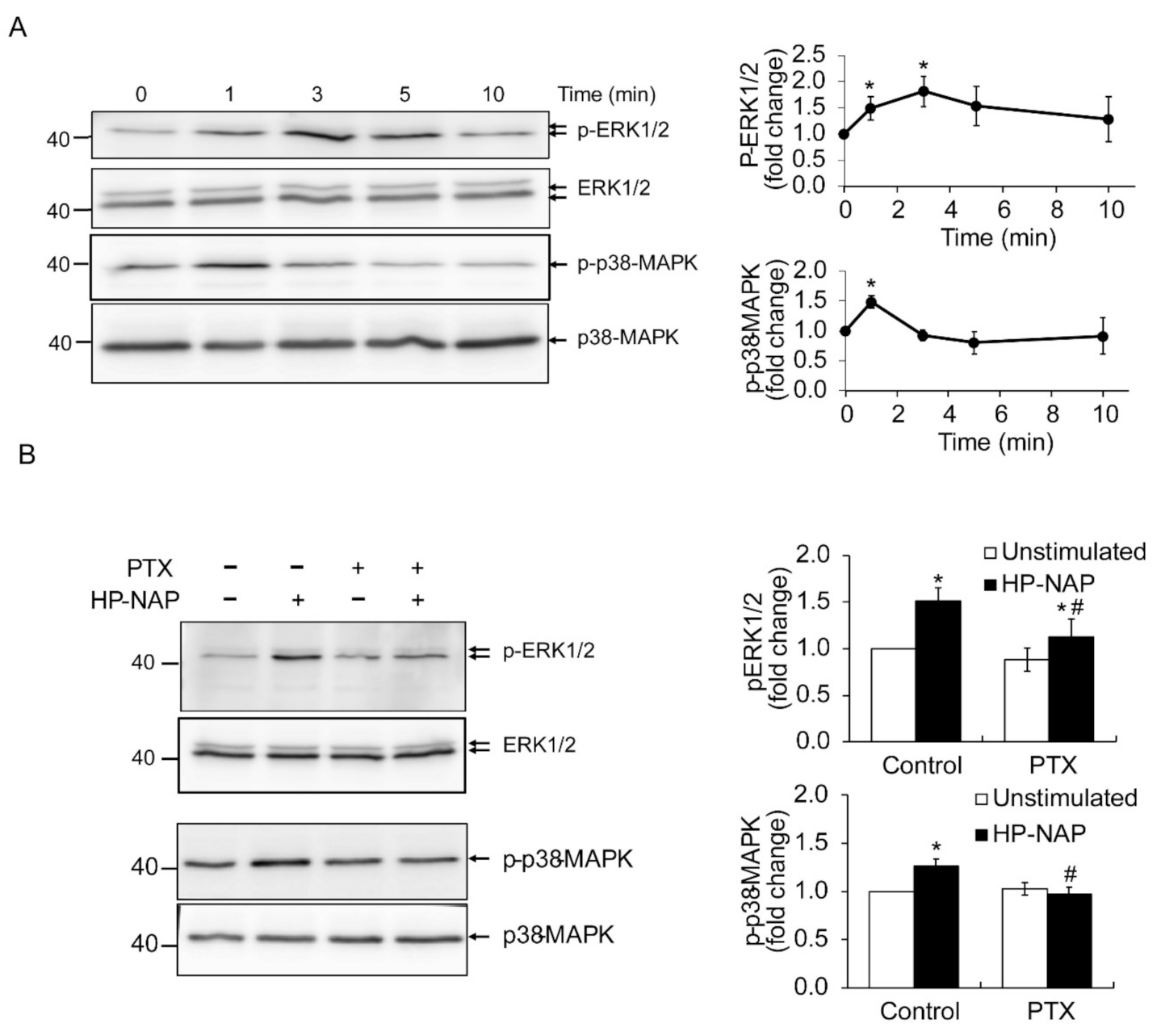
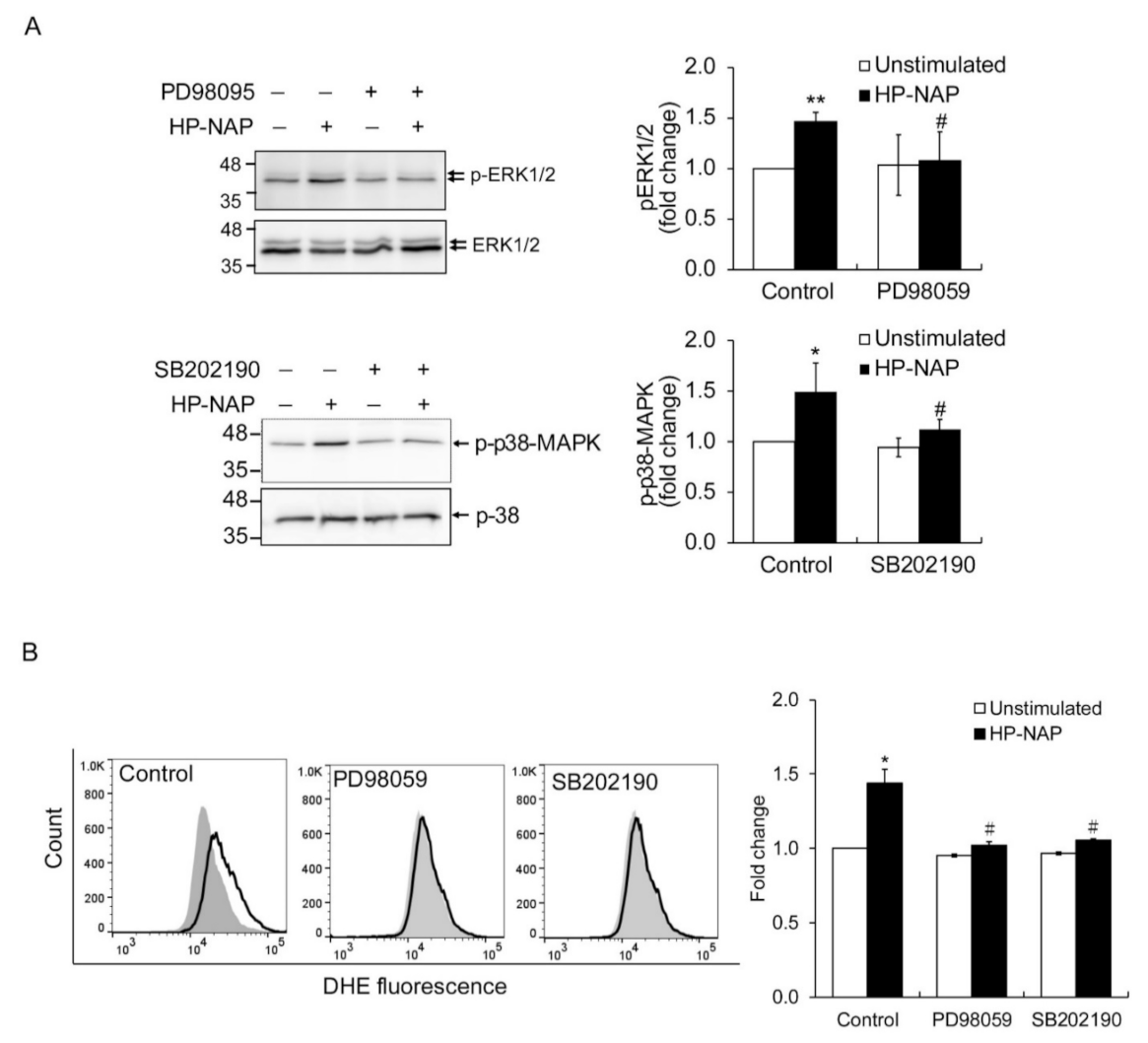


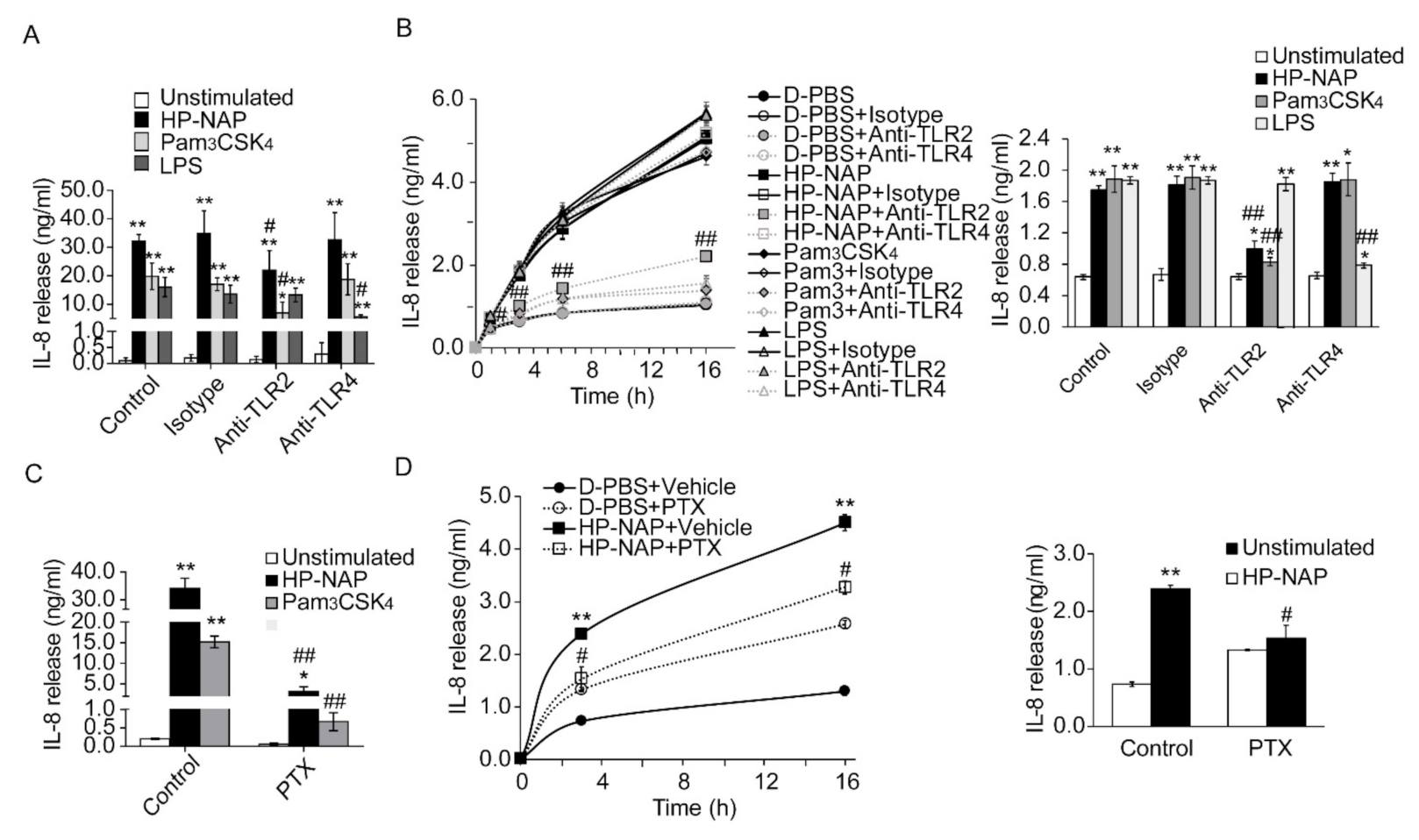
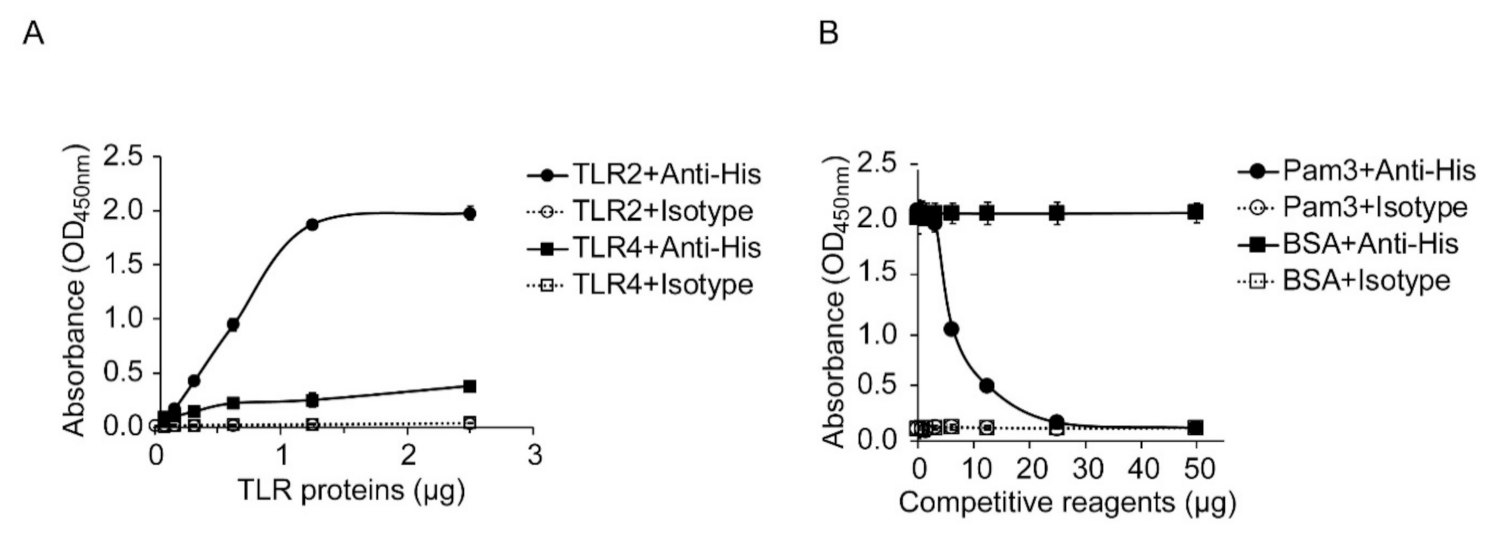
| Name of the Antibody | Clonality | Host | Clone | Catalog Number | Concentration or Dilution Factor | Source |
|---|---|---|---|---|---|---|
| APC mouse anti-human CD11b/Mac1 | Monoclonal | Mouse | ICRF44 | 561015 | 1:5 b | BD Bioscience, Franklin Lakes, NJ, USA |
| APC mouse IgG1κ isotype control | Monoclonal | Mouse | MOPC-21 | 550854 | 1:5 b | BD Bioscience, Franklin Lakes, NJ, USA |
| 6x His tag | Monoclonal | Mouse | GT359 | GTX628914 | 50 μg/mL e | GeneTex, Hsinchu, Taiwan |
| mouse IgG2aκ isotype control | Monoclonal | Mouse | eBM2a | 16-4724-85 | 10 μg/mL c | eBioscience, San Diego, CA, USA |
| mouse IgG3 isotype control | Monoclonal | Mouse | B10 | GTX35027 | 50 μg/mL e | GeneTex, Hsinchu, Taiwan |
| p38α | Polyclonal | Rabbit | N/A a | sc-535 | 1:1000 d | Santa Cruz Biotechnology, Santa Cruz, CA, USA |
| peroxidase-conjugated goat anti-mouse IgG (H+L) | Polyclonal | Goat | N/A a | 115-035-003 | 1:5000 d; 25 µg/mL e | Jackson ImmunoResearch, West Grove, PA, USA |
| peroxidase-conjugated goat anti-rabbit IgG (H+L) | Polyclonal | Goat | N/A a | 111-035-003 | 1:5000 d | Jackson ImmunoResearch, West Grove, PA, USA |
| phospho-ERK1/2 | Monoclonal | Mouse | E-4 | sc-7383 | 1:3000 d | Santa Cruz Biotechnology, Santa Cruz, CA, USA |
| phospho-p38 MAPK (Thr180/Tyr182) | Monoclonal | Rabbit | D3F9 | 4511 | 1:1000 d | Cell Signaling, Beverly, MA, USA |
| p44/42 MAPK (ERK1/2) | Antiserum | Rabbit | N/A a | M5670 | 1:3000 d | Sigma, St Louis, MO, USA |
| TLR2 | Monoclonal | Mouse | TL2.1 | 16-9922-82 | 10 μg/mL c | eBioscience, San Diego, CA, USA |
| TLR4 | Monoclonal | Mouse | HTA125 | 16-9917-82 | 10 μg/mL c | eBioscience, San Diego, CA, USA |
Publisher’s Note: MDPI stays neutral with regard to jurisdictional claims in published maps and institutional affiliations. |
© 2021 by the authors. Licensee MDPI, Basel, Switzerland. This article is an open access article distributed under the terms and conditions of the Creative Commons Attribution (CC BY) license (https://creativecommons.org/licenses/by/4.0/).
Share and Cite
Wen, S.-H.; Hong, Z.-W.; Chen, C.-C.; Chang, H.-W.; Fu, H.-W. Helicobacter pylori Neutrophil-Activating Protein Directly Interacts with and Activates Toll-like Receptor 2 to Induce the Secretion of Interleukin-8 from Neutrophils and ATRA-Induced Differentiated HL-60 Cells. Int. J. Mol. Sci. 2021, 22, 11560. https://doi.org/10.3390/ijms222111560
Wen S-H, Hong Z-W, Chen C-C, Chang H-W, Fu H-W. Helicobacter pylori Neutrophil-Activating Protein Directly Interacts with and Activates Toll-like Receptor 2 to Induce the Secretion of Interleukin-8 from Neutrophils and ATRA-Induced Differentiated HL-60 Cells. International Journal of Molecular Sciences. 2021; 22(21):11560. https://doi.org/10.3390/ijms222111560
Chicago/Turabian StyleWen, Shao-Hsuan, Zhi-Wei Hong, Chung-Chu Chen, Han-Wen Chang, and Hua-Wen Fu. 2021. "Helicobacter pylori Neutrophil-Activating Protein Directly Interacts with and Activates Toll-like Receptor 2 to Induce the Secretion of Interleukin-8 from Neutrophils and ATRA-Induced Differentiated HL-60 Cells" International Journal of Molecular Sciences 22, no. 21: 11560. https://doi.org/10.3390/ijms222111560
APA StyleWen, S.-H., Hong, Z.-W., Chen, C.-C., Chang, H.-W., & Fu, H.-W. (2021). Helicobacter pylori Neutrophil-Activating Protein Directly Interacts with and Activates Toll-like Receptor 2 to Induce the Secretion of Interleukin-8 from Neutrophils and ATRA-Induced Differentiated HL-60 Cells. International Journal of Molecular Sciences, 22(21), 11560. https://doi.org/10.3390/ijms222111560






